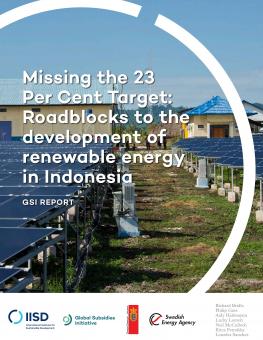
Missing the 23 Per Cent Target: Roadblocks to the development of renewable energy in Indonesia
This report seeks to answer the question of why renewable energy deployment, particularly wind and solar, has not taken off in Indonesia. To understand the forces shaping the sector, and what can be done to remedy the situation, IISD conducted interviews with politicians, civil servants, industry representatives, renewable energy developers, civil society organizations, international donors and other stakeholders. A total of 26 interviews took place, revealing the roots of the problem, the broader political economy of the energy sector and some possible ways forward.
On January 25, 2017, Indonesian Minister of Energy and Mineral Resources (ESDM) Ignasius Jonan stated, “Indonesia is resolved to increasing its new and renewable energy mix to 23 per cent in 2025 in line with its commitment to reducing its greenhouse gas emissions it had made during the COP 21 conference in Paris in 2015.”
The commitment to increase renewable energy was made as part of a package of measures to tackle climate change in Indonesia’s Nationally Determined Contribution (NDC) that pledged to reduce emissions by 26 per cent against the business-as-usual scenario by 2020 and 41 per cent if international support is granted.
With this high-level commitment to a marked expansion of renewable energy—together with the international context of falling renewable energy prices—one might expect that renewable energy in Indonesia would be booming. However, since 2007 most of the increase in electricity production has come from coal and the share of renewable electricity production has remained relatively static, at around 12 per cent of total generation.
Between 2007 and 2016 hydro and geothermal capacity increased by 39 and 67 per cent respectively. But overall installations pale in comparison to coal, while solar remains almost nonexistent (45 MW total).
This report seeks to answer the question of why renewable energy deployment, particularly wind and solar, has not taken off in Indonesia. To understand the forces shaping the sector, and what can be done to remedy the situation, IISD conducted interviews with politicians, civil servants, industry representatives, renewable energy developers, civil society organizations, international donors and other stakeholders. A total of 26 interviews took place, revealing the roots of the problem, the broader political economy of the energy sector and some possible ways forward.
Additional downloads
You might also be interested in
How Fossil Fuels Drive Inflation and Make Life Less Affordable for Canadians
New report takes closer look at how Canada’s dependence on fossil fuels impacts energy costs and prices of essentials such as transportation, home heating, and housing.
Securing India's Copper Supply
This policy brief emphasizes the need for India to develop a comprehensive copper strategy.
The Indonesia Cooking Diaries Study
This study evaluates the feasibility and implications of switching from cooking with LPG to induction stoves in Indonesian households.
Report Calls on Fossil Fuel Producers to Map “Transition Away” in NDCs
With governments due to submit the next generation of NDCs in 2025 a new report identifies five elements countries should include to reflect the outcome of the global stocktake.